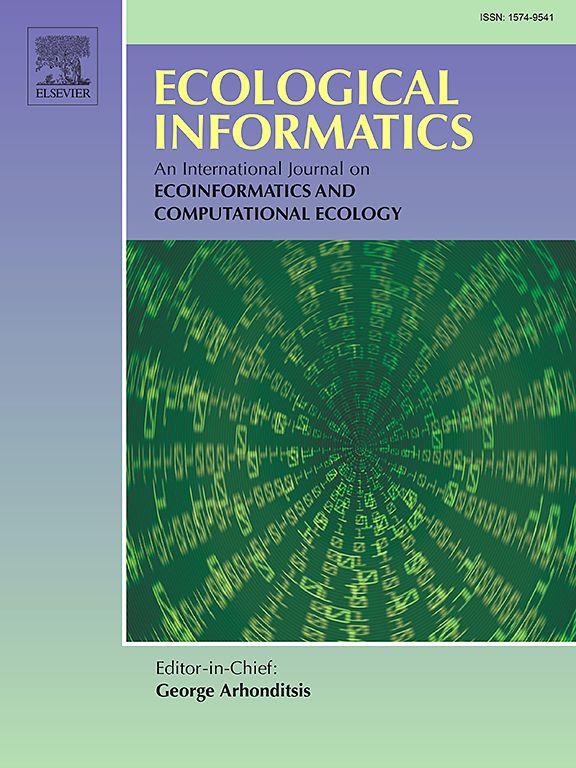基于聚类样本的地理空间机器学习预测评估的差异性自适应交叉验证方法
IF 5.8
2区 环境科学与生态学
Q1 ECOLOGY
引用次数: 0
摘要
空间聚类样本在地理空间机器学习(ML)预测中很普遍,特别是在生态制图中。由于预测区域的密集采样区域被过度代表,导致样本和预测之间的数据分布不相似,从而对地理空间ML预测的评估提出了明显的挑战。随机交叉验证和空间交叉验证(CV)方法都不能一致地得出准确的评价:随机交叉验证在聚类高时高估了预测性能,而空间交叉验证在聚类低时低估了预测性能。为了解决这一挑战,我们提出了一种新的“自适应”评估方法,称为不相似度-自适应交叉验证(DA-CV),该方法基于数据特征空间。DA-CV根据预测位置的协变量与采样位置的协变量之间的不相似性,将预测位置分为“相似”和“不同”组。DA-CV应用随机CV来评估“相似”的位置,应用空间CV来评估“不同”的位置。最终的评价指标是通过两者的加权平均得到的。为了验证DA-CV,我们在合成物种丰度和真实地上生物量数据集上进行了一系列实验,其中聚类程度逐渐变化,并在实验中将DA-CV与现有的CV方法(RDM-CV、SP-CV和kNNDM)进行了比较。结果显示,DA-CV在85%的情况下提供了最准确的评估。DA-CV有效地克服了随机和空间CV方法的共同局限性,例如在评估中只考虑部分预测。这意味着DA-CV可以为聚类样本的大多数情况提供准确的评估。DA-CV的成功证实了考虑特征空间信息是提高地理空间ML预测评价的有效方法。本文章由计算机程序翻译,如有差异,请以英文原文为准。
A dissimilarity-adaptive cross-validation method for evaluating geospatial machine learning predictions with clustered samples
Spatially clustered samples are prevalent in geospatial machine learning (ML) predictions, especially in ecological mapping. Since densely sampled regions in the prediction area are overrepresented, leading to dissimilarities in the data distribution between samples and predictions and thus posing a noticeable challenge for the evaluation of geospatial ML predictions. Neither random nor spatial cross-validation (CV) methods can consistently yield accurate evaluations: Random CV overestimates prediction performance when clustering is high, while spatial CV underestimates it when clustering is low. To tackle this challenge, we propose a novel “adaptive” evaluation method called dissimilarity-adaptive cross-validation (DA-CV), which is based on the data feature space. DA-CV categorizes the prediction locations as “similar” and “different” groups according to the dissimilarity between their covariates and those of the sampled locations. DA-CV applies random CV to evaluate “similar” locations and spatial CV to evaluate “different” ones. The final evaluation metric is obtained through a weighted average of the two. To test DA-CV, we conducted a series of experiments on synthetic species abundance and real above ground biomass datasets, where the clustering degree was gradually changed, and we also compared DA-CV with current CV methods (RDM-CV, SP-CV, and kNNDM) in the experiments. Results showed that DA-CV provided the most accurate evaluations in 85% of scenarios. DA-CV effectively overcomes the common limitations of random and spatial CV methods, such as only considering a part of predictions in the evaluation. This means that DA-CV can provide accurate evaluations for most situations of clustered samples. The success of DA-CV confirms that considering feature space information is an effective way to improve the evaluation of geospatial ML predictions.
求助全文
通过发布文献求助,成功后即可免费获取论文全文。
去求助
来源期刊

Ecological Informatics
环境科学-生态学
CiteScore
8.30
自引率
11.80%
发文量
346
审稿时长
46 days
期刊介绍:
The journal Ecological Informatics is devoted to the publication of high quality, peer-reviewed articles on all aspects of computational ecology, data science and biogeography. The scope of the journal takes into account the data-intensive nature of ecology, the growing capacity of information technology to access, harness and leverage complex data as well as the critical need for informing sustainable management in view of global environmental and climate change.
The nature of the journal is interdisciplinary at the crossover between ecology and informatics. It focuses on novel concepts and techniques for image- and genome-based monitoring and interpretation, sensor- and multimedia-based data acquisition, internet-based data archiving and sharing, data assimilation, modelling and prediction of ecological data.
 求助内容:
求助内容: 应助结果提醒方式:
应助结果提醒方式:


